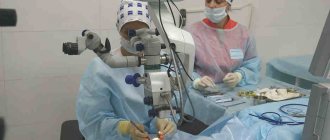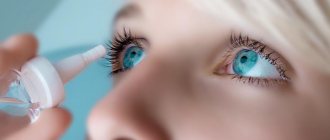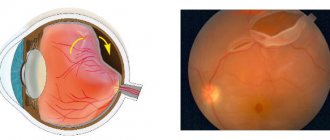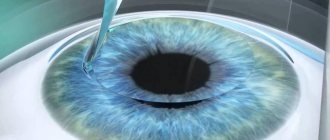Myopia symptoms
Often people do not notice the slow and gradual deterioration of vision; they blame it on prolonged sitting at the computer or simple fatigue. Myopia manifests itself through:
- Deterioration of vision when looking into the distance.
- Blurring images in the distance. A person has to strain his eyesight to see this or that object.
- Although there are problems with visibility of distant objects, this does not apply to objects that are close. The patient still sees them well, or relatively well, in advanced cases.
- A person squints his eyes to better focus his vision. At first he does this unconsciously, then, as the disease develops, on purpose.
- Possibly protrusion of the eye due to an increase in the axis of the eyeball.
Not all symptoms may appear immediately. The appearance of at least one of the above symptoms is a reason to contact an ophthalmologist.
Causes of myopia
In case of myopia, the focus of the image does not reach some distance to the fundus of the eye, where the photosensitive cells of the retina are located.
There are many causes for the development of the disease, let’s consider the most common:
- Hereditary predisposition - if both parents suffer from myopia, there is a 50% chance that the child will develop this disease by adulthood or even earlier. Family habit also plays a role here; if the older generation does not take care of their eyesight, then their offspring will not do this either.
- Spending time at the computer, reading books placed at the wrong distance from the eyes, dim lighting, playing with gadgets or watching TV in the dark cause constant eye strain.
- To support sharp vision, the eyes need vitamins and microelements. Vision will decrease if they don't get what they need. This is especially true for those who have had vision problems since birth.
- Independent selection of vision correction products can only worsen the situation. Glasses or lenses that exceed the true “minus” of the patient will create additional eye strain, which will lead to the progression of the disease.
- A number of congenital causes that are not influenced by parents and genetics - congenital muscle weakness of the eyes, incorrect size of the eyeball.
- Sometimes myopia develops due to high intracranial and intraocular pressure, a traumatic brain injury, or complications after an infection.
It is not always possible to identify the cause of myopia.
Classification of the disease
Degrees of decrease in visual acuity:
- Mild myopia - visual impairment does not exceed 3 diopters. A person sees objects located far away blurry, but does not experience problems with objects located nearby.
- Moderate myopia is a refractive error of the eye ranging from 3 to 6 diopters. In the distance, the patient does not see anything without special means, but up close he sees without blurring what is within 30 cm of him.
- High myopia – visual impairment starts from 6 diopters and above. A person sees clearly only those objects that are directly “under his nose.” This deviation requires constant correction with glasses or lenses.
Myopia is also distinguished according to the nature of its development:
- Progressive – the disease develops rapidly, vision deterioration of more than 1 diopter per year. This happens during periods of intense visual stress.
- Transient - temporary visual impairment, it is affected by diabetes mellitus, lens edema, and taking certain medications. This myopia lasts no more than a month.
- Stationary – the disease does not progress, visual impairment remains at the same level. All you need is properly selected vision correction.
The degree and nature of the disease can be correctly established only after examination by an ophthalmologist using special diagnostic tools.
Question 96
I have astigmatism -5.
I heard that after LASIK the vision will be 1 only in the daytime. And at night it will get worse. Is it so? Larisa Answer:
Dear Larisa.
LASIK is a vision correction method that replaces glasses and contact lenses, allowing for maximum visual acuity for each individual. The quality of vision in the twilight will be no worse than when using glasses or contact lenses. Question 95
Hello, I have a question, I am now 17 years old and my myopia is -1.5 -2. I wear glasses, but it really bothers me. Can I undergo treatment at your center, or do I need to wait another year until I reach adulthood? And how much will the entire treatment cost? Thank you. Vadim
Answer:
Dear Vadim.
Laser correction of myopia (LASIK), which is performed in our center, is possible when the patient reaches 18 years of age. But you are still recommended to undergo an examination by our specialists now. This is necessary so that in a year we will have reliable information about your disease and the nature of its course. Appointments can be made by calling 737-000. Question 94
Hello, I am 30 years old, mild myopia -2.5 since I was 9 years old. Can my vision deteriorate again after the operation if I plan to become pregnant in the future? (They say that during childbirth there is some strain on the eyes.) Will there be any physical restrictions and for what period? How long does the postoperative period last and what treatment is required? Thank you. Natalia
Answer:
Dear Natalia.
Pregnancy and childbirth do not affect vision after laser correction. Within 14 days after surgery, it is undesirable to receive a direct severe injury to the eye, use cosmetics on the eyelashes, visit a swimming pool, which usually contains germs, a bathhouse, a sauna, or engage in active sports associated with the possibility of eye injury. For 8 days after surgery, you put anti-inflammatory drops into your eyes. You can start working 1-2 days after the operation. You can get more detailed information at an appointment with specialists at our center, make an appointment by calling 737-000. Question 93
Good afternoon! I am 27 years old. My vision is -3. Which surgery is right for me to remove my glasses and how much will the whole procedure cost? How long to wait in line and in what time frame can all procedures be completed? Hope
Answer:
Good afternoon, Nadezhda.
Myopia of -3.0 Diopters can be corrected using LASIK - this operation is currently the most effective, safe and predictable correction method. The next operational day on which we can accept you will be April 7. The operation itself lasts about 5 minutes for each eye; first (preferably several days in advance) you need to undergo an additional examination, which takes about an hour. The cost of a set of examinations is 1,500 rubles, the cost of the operation is 15,500 rubles for each eye. Appointments can be made by calling 737-000. Question 92
Hello! I have poor eyesight since the 3rd grade, I am 23 years old. I have myopia, I wear lenses in both eyes -2.5 (but I can’t see by one, doctors say that with such diopters my vision is 0.8). Tell me what to do? I heard about laser surgery, I’m interested in the cost and what guarantees are there that my vision will not deteriorate after this operation? Katerina
Answer:
Dear Katerina.
In our clinic we perform laser correction of myopia using the LASIK method. You can have surgery and the preliminary prognosis for vision without glasses is 80%, but it may be more, which will be determined in advance during the examination. If you have surgery, your vision will be stable throughout your life. The cost of the examination is 1,500 rubles, the cost of the operation is 31,000 rubles for both eyes. 3 days before the examination, you need to remove contact lenses and you cannot drive a car on the day of the examination. You can make an appointment by calling 737000. Question 91
I have complex farsighted astigmatism in both eyes. Can it be cured or somehow fixed? Marina
Answer:
Dear Marina.
In our clinic we perform laser correction of farsightedness and astigmatism, which improves vision using the LASIK method, including complex hyperopic vision. The result may depend on the number of diopters and visual acuity in glasses. In order to find out whether surgical correction is possible, you need to be examined by our specialists. You can make an appointment by calling 737-000. Question 90
Hello. I am 29 years old. I have been suffering from myopia for two years, I have -1, I use glasses only in extreme cases. Is it possible to restore vision using the services of your clinic? What kind of surgery is needed and how much will it cost? Thank you. Alexei
Answer:
Dear Alexey.
Our clinic performs laser correction of myopia using the LASIK method. In order to determine the possibility of surgery, you need to undergo a specialized examination by our specialists. The cost of the operation is 15,500 rubles. one eye, preoperative examination - 1500 rubles. Appointments are by appointment; you can make an appointment by calling 737-000. Question 89
Hello! I am 35 years old, for the last 20 years my vision has been “-5.5”. I would like to make an appointment with you. Two questions: 1) How much time currently passes between the first visit to a specialist and the actual operation? (in a standard situation) 2) Is it possible to leave the clinic independently by car an hour or two after the operation? (I'm from Kurchatov) Thank you! Vitaly
Answer:
Dear Vitaly.
1. Between the first visit and the operation itself, at least a day passes, provided that you contact us with the necessary tests (blood for syphilis, HIV, HBsAg and anti-HCV antibodies) or come for examination before 14:00 and take the tests in our clinic. A full package of examinations for LASIK costs 1,500 rubles, the necessary tests cost 880 rubles. We have operating days once every 2 weeks, most often on Thursdays, the nearest one is March 10. 2. You will be able to leave the clinic in 30-40 minutes. after surgery, but we do not recommend driving for 1-2 days after surgery. Appointments can be made by calling 737-000. Question 88
Hello, I have a question: should I have surgery if OD is -0.75; OS -0.5? about 3 months ago I began to notice a deterioration in distance vision in the right eye and slight double vision of an object with a shadow, especially in the evening. I had my eyesight checked and prescribed glasses for the distance, thank you in advance! Sergey
Answer:
Dear Sergey.
Unfortunately, you did not indicate your age. Sometimes the strength of the prescribed glasses differs significantly from the actual myopia. In order to answer all your questions, it is advisable to undergo an examination by specialists at our clinic. You can make an appointment by calling 737-000. Question 87
Good afternoon. I am 25 years old, I have had myopia since childhood (I had a fracture in my right arm at the age of 6, I had surgery and after that my vision began to deteriorate) now -4.5. I work constantly at the computer; after eye surgery, it is advisable not to sit at the monitor for some time. Alexander
Answer:
Dear Alexander. If you are myopic and at your age, laser correction using the LASIK method, which is performed in our clinic, is possible if there are no other contraindications that can only be determined after a special preoperative examination. There are no contraindications to working with a computer in the postoperative period. However, it will be difficult to look closely for about a day after the operation, but it will pass quickly. In the postoperative period, you will need to instill drops for a week, not visit the sauna, swimming pool, avoid getting water and soap in your eyes and avoid eye injuries for 2 weeks.
Diagnosis of myopia
For mass examination of people's vision, they use Sivtsev's table.
The patient assumes that he is myopic when he notices certain symptoms, but only an ophthalmologist will make a diagnosis such as myopia; the following methods will help him with this:
- Visometry is an ophthalmological test to determine visual acuity.
- Biomicroscopy – examination of the structure of the eye.
- The procedure for studying the refraction of the eye - using computer refractometry or a simpler method - skiascopy.
- Procedures for direct ophthalmoscopy or biomicroscopy of the eye are carried out if it is necessary to identify changes that have appeared on the retina of the eye, clouding of the lens, etc.
- The doctor may prescribe an ultrasound of the eye when there is a need to measure the anterior-posterior axis of the eye and the size of the lens.
- An ophthalmologist will measure the length of the eye and determine the degree of myopia.
Optical correction of myopia
To use glasses to correct myopia gradually decreases.
This option for vision correction for myopia is simple, painless and quick. An experienced professional will select “ideal vision” for the client within 10 minutes. Glasses and contact lenses will refract the rays in such a way that the projection of the observed object will be carried out in the desired area on the retina.
Each type of optical correction has advantages and disadvantages. The glasses will be easier to use, safer from a hygiene point of view, and cheaper to operate. But young people and girls are embarrassed to wear them, glasses can easily be broken, and in the cold season and in rainy weather they bring a lot of inconvenience.
Contact lenses look more aesthetically pleasing; a non-professional will not even notice that they are on their eyes. The properties of lenses do not change, despite the time of year, day, or weather conditions.
If a nearsighted person has infectious eye diseases, allergies or hypersensitivity, it is better to avoid using contact lenses.
Also, the disadvantages of contact lenses include: price, high risk of infection if care recommendations are not followed.
Is laser vision correction worth it?
Doctors state: there are fewer and fewer people with good vision, and the number of glasses and contact lens wearers is increasing every day. There are many reasons for this. The quality of vision may depend on heredity, eye diseases, and injuries. Sitting at the computer for a long time does not add health to our eyes. Eye problems are solved in different ways. For some, it is enough to wear glasses, for others, surgery is necessary, and in some cases, special exercises can improve visual acuity. Marina Dzhumova, Associate Professor of the Department of Eye Diseases of the Belarusian State Medical University, told during a direct line held in Znamenka what to do in certain cases.
— Is it possible to play sports after eye surgery and what kinds of activities are generally allowed without harm to health? Alina Nikolaevna (question from the site)
— It all depends on the operation and the condition of the retina. If the reader means laser vision correction, then there are no restrictions on playing sports if there are no changes in the fundus. If there are pronounced changes in the retina associated with myopia, then playing any sports is contraindicated, since stress can provoke retinal detachment. In each case, the issue is resolved by the ophthalmologist individually.
— Is laser correction a surgical intervention? What loads are indicated after such an operation? Andrey, Minsk
— Yes, this is laser refractive surgery. It combines a number of procedures that are performed to change the refraction of the eye by affecting the cornea or lens. LASIK is the most common refractive procedure in recent times. It provides correction of hypermetropia up to 4 diopters, astigmatism without restrictions and myopia up to 12 diopters depending on the thickness of the cornea. If there are no changes in the fundus, you can play sports. Changes in the retina associated with myopia (thinning, tears, peripheral degeneration) limit sports activities. You cannot lift weights, do work with your head tilted, engage in strength sports, jumping, running, etc. Any sudden movements are contraindicated.
— Is it possible to give birth naturally after refractive eye surgery? Marina, Orsha
— It all depends on the condition of the retina. All restrictions are associated with this. If there are no changes in the retina, you can give birth naturally. In case of high myopia, it is necessary to examine the retina in the third trimester of pregnancy, i.e. examine the fundus. If ruptures, pre-ruptures, or peripheral degenerations that predispose to retinal detachment are found in the retina, you should definitely contact the laser center and perform laser coagulation of the retina. If there is a threat of retinal detachment, natural delivery is contraindicated. In each specific case, this issue is decided by an ophthalmologist.
— I want to do laser vision correction. But now I am in the first months of pregnancy. When is it better to do this: now or after childbirth? Anna, Polotsk
— Laser vision correction can be done three months before the planned pregnancy. But during pregnancy and breastfeeding - no. It will be possible to do it after childbirth and cessation of lactation.
— What physical and visual limitations may there be after laser vision correction surgery? And are there any contraindications for such an operation? Mikhail Davidovich, Minsk
— In the first week after laser correction, physical activity is contraindicated and you should not go to the pool. Limitations are associated with possible displacement of the corneal flap and its subsequent deformation and wrinkling. Further physical limitations are associated with the condition of the retina. There are no visual restrictions. The operation is characterized by rapid visual rehabilitation and stabilization of refraction, minimal risk of corneal opacities. Contraindications for the operation are pregnancy and lactation, chronic inflammatory eye diseases (blepharitis, conjunctivitis, keratitis, keratouveitis, etc.), glaucoma, cataracts, keratoconus. If you have diabetes, it is better to avoid surgery. — Is the eye open after such an operation or is a bandage applied? — The bandage is not applied, the eye is open. Therefore, it is important that the flap does not become displaced. The operation is associated with minimal discomfort.
— Approximately how much is removed from the thickness of the cornea during laser correction surgery and how safe is additional correction? Lyudmila Alexandrovna, Molodechno
— The volume of tissue removed and the effect of the intervention are limited by the initial thickness of the cornea. To avoid corneal ectasia (progressive thinning and increased curvature of the cornea with irregular astigmatism, leading to poor vision), the thickness of the residual stroma after flap formation and tissue ablation (removal) should be at least 450 microns. How safe is additional correction? If this is within the specified corneal thickness, then additional correction is safe.
— For what eye diseases would you not recommend laser correction? Sergey Anatolyevich, Zhodino
- Glaucoma, cataracts, diabetes mellitus, inflammatory eye diseases (blepharitis, conjunctivitis, uveitis, keratitis (especially herpetic keratitis).
— What consequences can occur after unsuccessful eye surgery? Tatiana, Orsha
— It depends on the method of surgical intervention. Various methods of laser refractive surgery are possible. There are intra- and postoperative complications. For example, after LASIK surgery (laser in situ keratomileusis), complications are associated with damage to the flap (formation of a thin flap, “perforated” holes, uneven flap, etc.). Postoperative complications include shrinkage, distortion or displacement of the flap, epithelial defects, subepithelial opacities that can cause night blindness, and sometimes diffuse lamellar keratitis or bacterial keratitis. Quite often there is dry eye syndrome, when patients complain of a feeling of dryness and burning in the eyes. In such cases, tear substitutes are used, drugs that moisturize the eye: natural tears, Systane, Oxyal, Hilo-Komodo, Vidisic and others. It is necessary to consult with an ophthalmologist, since the choice of drug is decided individually. I must say that in most cases, laser refractive surgery occurs without complications.
— How long does the Lasik surgery last and how quickly after it can you lead your normal life? Elena, Minsk
— Laser ablation lasts up to 2 minutes. The total operation time for both eyes is 30-40 minutes. The operation causes minimal discomfort, rapid visual rehabilitation and rapid stabilization of refraction. The risk of corneal clouding is minimal. For the first few days after surgery, you should limit physical activity to avoid injury to your eyes.
— What methods of vision correction exist? How safe is it to wear contact lenses and do they scratch your eyes? Andrey, Minsk
— For vision correction, glasses, contact lenses and laser refractive surgery are used. The right way, in my opinion, is this: if a person tolerates glasses well, he should wear them. This is the safest correction method. If there are medical indications or a person does not like wearing glasses (for example, there is not sufficient visual acuity, the field of view is worse), he can wear contact lenses. Most of the oxygen for corneal metabolism comes from the atmosphere and the tear film. The contact lens is located within the tear film and creates a barrier to the penetration of oxygen into the cornea. The movement of the lens and the circulation of tears behind the lens is an important mechanism for delivering oxygen to the cornea. With a tight-fitting lens, mechanical and hypoxic tissue damage is possible. The cornea can be damaged by a contact lens or a foreign body caught under the lens. The correct fit of the lens is determined by the doctor. Untimely replacement of contact lenses, poor hygiene and incorrectly selected lenses can cause complications. The oxygen permeability of the contact lens (DK/t value) may be insufficient. Patients cannot wear contact lenses continuously. They can be an addition to glasses. In the presence of complications (superficial punctate keratitis, tight lens syndrome, epithelial microcysts, chronic hypoxia and vascularization, infiltrates, allergic and toxic reactions, corneal ulcer), a reduction in the time of wearing the lens or stopping wearing it altogether is indicated. An increase in oxygen permeability is achieved by replacing lenses with silicone hydrogel soft contact lenses. The risk of complications increases when patients with ophthalmopathology wear lenses. Patients with inflammatory diseases (acute rhinitis, tonsillitis, conjunctivitis, blepharitis) should not use contact lenses. Wearing contact lenses can lead to bacterial keratitis and corneal ulcers. In such cases, contact lenses should be removed until recovery. — How long can you wear contact lenses? - Depends on the type of lens. Daily wear lenses of medium hydrophilicity are recommended to be worn for 6-8 hours; in the evening they are removed and treated in special solutions. Lenses can be soft or hard and are made from various materials. Soft contact lenses are divided into daily replacement lenses (the safest - put them on in the morning, throw them away in the evening), frequent scheduled replacement (service life 7-14 days), scheduled replacement (lens replacement once a month), traditional (service life 6-12 months) . Flexible wearing mode means that sometimes the lens can be left in place for 1-2 nights; continuous wearing mode means that the lens can be worn without removing it for a month. I am not a proponent of continuous lens wear, since bacterial keratitis may develop. During wear, proteins and cellular detritus, lipids, cosmetics, and salts are deposited on the lens and come into contact with the surface of the eye. Treatment products can cause acute or chronic keratopathy. Contact lenses must be changed promptly. — Are laser surgeries performed at the 3rd Clinical Hospital in Minsk? And what is Lasik surgery? — The laser center of the 3rd Clinical Hospital performs various types of laser procedures for glaucoma, secondary membranous cataracts, laser photocoagulation of the retina for various pathologies (diabetes, myopia, thrombosis, etc.), photodynamic therapy for retinal diseases and operations on the adnexal apparatus of the eye. We do not perform laser refractive surgery. These procedures are performed by two commercial ones and New Vision. The LASIK procedure is designed to change the refraction of the eye by affecting the cornea. Using a microkeratome, a very thin flap of epithelium is formed, located on the basement membrane, laser ablation is performed (removal of corneal tissue to a given depth using an excimer laser), the flap is placed in place and held at rest for 30 seconds. When correcting myopia, tissue is removed in the central zone of the cornea, which leads to its flattening; to correct hypermetropia, ablation is performed on the periphery of the cornea, which makes the cornea steeper in the center. - Thank you.
— At what age and in what cases can children wear contact lenses? And what if you have an infectious disease (keratitis)? Oleg, Vitebsk
— Children can wear contact lenses from the age of 12 if they have refractive errors. Parents should supervise the treatment of lenses. Lenses can be worn at an earlier age (for example, with aphakia - the absence of a lens). The issue should be resolved individually by a doctor in a contact correction room. The presence of infection (chronic conjunctivitis, blepharitis) is a contraindication for wearing lenses. In this case, wearing glasses is indicated. Wearing contact lenses after suffering from keratitis is not recommended, since it can injure the cornea and cause a relapse of the disease.
- I am farsighted. I wear glasses. I work at the computer for a long time. The eyes get very tired - to the point of pain and acute stinging. This sometimes does not go away even after sleep and after days off. What to do? Arkady, Maryina Gorka
— With moderate and high farsightedness, patients need distance and reading glasses. In this case, we can recommend limiting work with the computer for a certain period of time. Work at the computer only during the working day, and after work give your eyes a rest. It often happens that a person comes home from work and sits down at the computer again in the evening. It is important to choose the right glasses from your ophthalmologist. Eye exercises are useful. The simplest exercise is to look into the distance for 30 seconds, at a close distance for 30 seconds for three minutes. The exercise can be performed several times a day. In the eye we have the ciliary muscle, which is overstrained during visual work at close range. By the evening, when working at a computer or reading for a long time, dry eye syndrome may develop. Patients complain of burning, dryness, and a feeling of a foreign body, which intensify during the day. Dry eye syndrome is exacerbated by external factors that accelerate the evaporation of tear fluid (for example, air conditioning, wind or central heating). Drugs for moisturizing the eyes are indicated: natural tear, Systane, Oxyal, Vidisik, Hilo-Komodo and others. If the effect is insufficient, a patient with farsightedness may be advised to wear contact lenses or refractive surgery.
- I am 45 years old. My eyes have been watering for a long time (for 15-20 years now). This is especially true with the onset of spring, when strong winds begin. Or on a sunny winter day. You even have to wear glasses, but this doesn’t always help. I consulted a doctor. He prescribed some kind of gel. Moreover, you need to use it constantly. But is it possible to prescribe the drug for an unlimited period? What could cause this lacrimation and how to deal with it? Raisa Adamovna, Glubokoe
- It is necessary to find out the cause of prolonged lacrimation. This may be a violation of lacrimal drainage (displacement of the lacrimal punctum, obstruction along the drainage system - from the lacrimal punctum to the nasolacrimal canal). Tearing increases when exposed to cold and windy weather and decreases in a warm, dry room. After clarifying the patency of the lacrimal punctum, probing and washing of the nasolacrimal ducts in the clinic at the place of residence is indicated. The choice of treatment depends on the level of obstruction. If the nasolacrimal duct is obstructed, surgical treatment is indicated - creating an anastomosis between the lacrimal sac and the nasal mucosa (dacryocystorhinostomy). Tear hypersecretion may be associated with inflammation or damage to the ocular surface. The treatment is therapeutic. Sagging of the lower eyelid can lead to disruption of the tear suction mechanism and tear flow. Treatment depends on the cause of lacrimation and is prescribed individually by the ophthalmologist. — What can cause fusion of the nasolacrimal duct? - In adults - chronic rhinitis, idiopathic stenosis, nasoorbital trauma, surgical interventions on the nose and sinuses. For reflex lacrimation (bright sunny day, strong wind), wearing sunglasses is recommended. In case of inflammation or damage to the surface of the eye, drops are prescribed. — How long can they be buried? — The duration of instillation is determined by the doctor.
- Why do people have different visual acuity in their eyes? After all, we look at the world with both eyes with the same load, why then does one eye see better and the other worse? Tatyana, Logoisk
— The reason for different visual acuity may be different refraction of the eyes. There are emmetropia (commensurate refraction), myopia (nearsightedness), hypermetropia (farsightedness). For example, one eye may be nearsighted, and the other eye may be farsighted. Other options are also possible. As a result, one eye sees better at distances, the other at close ranges. Refraction is checked at an appointment with an ophthalmologist. If necessary, glasses are prescribed. - Can this happen from birth? - It can be either an acquired or a congenital condition. For example, with school myopia, the refraction can be the same or different in two eyes. The question of prescribing a correction is decided individually.
— Does working at a computer cause vision impairment? And how much time can a child spend on a computer? Maria, Minsk
- Of course, it provokes. Long-term visual work at close range, work at a computer contribute to the development of myopic refraction (myopia). Overstrain of accommodation when working at close range contributes to the formation of myopic refraction. Therefore, it is advisable to limit the time you work at the computer. This is especially true for children. For them, the maximum duration of work at the computer is 0.5 hours per day.
— I have mild astigmatism, I wear reading glasses. I am planning to have laser correction. I would like to ask a specialist whether I need to do this or not? Alexander Vyacheslavovich, Minsk
— For direct and reverse astigmatism up to 2.0 diopters, spectacle correction helps well. A conclusion about the need for laser refractive surgery can only be given after a complete examination by an ophthalmologist. — Are there effective methods for treating cataracts without surgery? I heard from someone (or maybe on TV) that cataracts are washed out with water? How is that? — Cataract is clouding of the lens. In the initial stages of acquired cataracts, vitamin drops are prescribed to improve metabolic processes in the lens. Surgical removal of the cloudy lens is the main treatment for cataracts. There are no other effective treatments. Phacoemulsification is the most preferred method of cataract extraction (removal). The technology involves the destruction of the lens nucleus by mechanical vibrations of ultrasound. “Washing out cataracts with water” refers to Alcon's AquaLase technology. This is a hydrodynamic destruction of the core due to the injection of a BCC solution heated to 60 degrees Celsius with a frequency of 50 pulses (injections) per second. The chemical composition of the solution closely matches the intraocular fluid. The technology is less effective than mechanical crushing of the kernel using ultrasound vibrations, since the inhabitants of Belarus are characterized by denser kernels.
- My eyes are red. This is especially noticeable after taking a hot shower. With what it can be connected? Oleg Nikolaevich, Borovlyany village
— There is no definite answer. You may have an allergic reaction to water, shampoo, or soap. We are surrounded by a large number of allergens - household, food, medicinal, airborne. The cause of red eyes can be chronic blepharitis and conjunctivitis. Redness of the eyes and deterioration of visual performance in the evening can develop with dry eye syndrome and prolonged work at the computer. A consultation with an ophthalmologist is indicated to determine the need for treatment.
— My cornea and the edges of my eyelids turn red, especially in the cold season. Outwardly, it looks like I just cried. In addition, upon closer examination, some bubbles (pimples) are visible at the base of the eyelashes, but the eyelids do not itch. I visited ophthalmologists many times. They say it's some kind of tick. They prescribe treatment, but at the same time they say that treatment is useless. And my eyelashes have thinned and become uneven. Maybe they'll fall out completely. What to do? Lyudmila (question from the site)
— The patient may have blepharitis. Anterior blepharitis affects the portion of the eyelid around the base of the eyelashes and may be associated with a staph infection or seborrhea. Hard scales and crusts are identified at the base of the eyelashes. Seborrheic blepharitis is usually associated with seborrheic dermatitis, which can affect the scalp. The cause of posterior blepharitis is dysfunction of the meibomian glands and changes in the properties of their secretion. The viscosity of the secretion increases, its outflow is disrupted, and the openings of the excretory ducts become clogged with sebaceous plugs. Long-term treatment is required, possibly throughout life. A definitive cure for blepharitis is unlikely, but improvement is possible. Warm compresses are recommended for a few minutes to soften the crusts at the base of the eyelashes, their mechanical removal using a cotton swab dipped in a solution of baby shampoo, and massage of the eyelids. Tetracycline antibiotics are prescribed by a doctor. Repeated courses of treatment may be necessary. Demodectic blepharitis is caused by an opportunistic parasite - a mite of the genus Demodex. The disease of the eyelids occurs as dry or oily seborrhea, accompanied by dysfunction of the meibomian glands, peeling of the eyelids (scales and grayish crusts between the eyelashes). Diagnosis of demodicosis is carried out by identifying mites on removed eyelashes in the direction of an ophthalmologist. The number of mites is considered pathological when 3-4 mites or more are detected on 6 eyelashes, normal - if there is only one mite or no mites are found at all. Parasite carriage in healthy people occurs in 40-90 percent of cases. Treatment is very difficult. It is recommended to treat the edges of the eyelids with a mixture of alcohol and ether, an aqueous solution of tansy, tincture of wormwood, and calendula. The eyelids are lubricated with zinc-ichthyol ointment, tetracycline, erythromycin, etc. Good results have been obtained with topical application of Demalan ointment. With severe and prolonged blepharitis, eyelash loss, abnormal growth, scarring of the eyelid margins and other complications are possible. Eyelid hygiene and long-term treatment are indicated. The treatment approach is individual and can only be prescribed by a doctor.
Prepared by Lyudmila SHESTOKOVICH, photo by Dmitry ELISEEV, ZN
Laser correction of myopia
Those who suffer from myopia will not have to resort to optical types of correction for the rest of their lives; laser correction is enough.
Laser correction will change the shape of the cornea of the eye, and in the future the image of objects will fall exactly on the retina, as the eye will again gain the ability to focus.
To prescribe laser correction by a doctor, you need to meet several parameters:
- Age from 18 to 55 years.
- Myopia from –1.0 to –15.0 diopters.
Unlike optical correction, laser correction has the main advantage that vision restoration will be permanent and not temporary.
Besides this, it has some other advantages:
- Quick – surgery on both eyes, including preparation, takes about 20 minutes. The vision itself will begin to recover within a few hours; the patient does not need to go to the hospital; he will go home 1–2 hours after the operation.
- No pain - an anesthetic is dropped into the eyes during the operation. There may be discomfort in the eyes after the operation. It is important to follow all the doctor’s prescriptions and recommendations, then this will pass very quickly.
- The guaranteed result is that the patient will receive good vision, which will remain with him for many years if he treats it with care in the future.
- Price – in recent years, laser vision correction has moved from expensive to very affordable. It is worth calculating the amount of money spent on lenses and related products in a year; it will be more than the price for one operation, which will give good vision for the rest of your life.
Laser vision correction - when and to whom can it be done?
Laser correction is a highly effective modern method of improving vision. The laser beam is directed at the cornea of the eye, which changes its shape under its influence. At the same time, the retina regains its ability to focus the image normally, which significantly improves vision. The price of laser vision correction is lower than the cost of a year's supply of daily lenses.
Positive aspects of laser vision correction
Currently, more and more people with vision problems are choosing this method of correction. Indeed, the uniqueness of this procedure is difficult to overestimate:
- This type of operation has been carried out for more than a quarter of a century. According to statistics, during this time thousands of people have significantly improved their vision. And this method is constantly being improved.
- Despite all the effectiveness of laser vision correction, it is completely safe and does not harm the eyes. The risk of complications after such an operation is practically reduced to zero.
- This procedure usually lasts no more than fifteen to twenty minutes. In this case, most of the specified time is spent preparing the patient for surgery, and the laser effect on the cornea itself lasts about a minute.
- This operation involves the use of local anesthesia. This eliminates the harmful effects of potent drugs on the body, as with general anesthesia. In this case, pain and any discomfort during the operation are completely absent.
- This method of improving vision is carried out on an outpatient basis, that is, the patient does not need to go to the hospital in order to prepare for the operation and recover after it.
- Immediately after the operation, the patient notes a significant improvement in vision. Within a week after the procedure, complete recovery occurs.
The recovery period after laser vision correction takes a minimum amount of time, subject to certain temporary conditions and restrictions:
- sleep exclusively on your back on the first day after the procedure,
- mandatory use of eye drops for the time specified by the doctor,
- minimal physical impact on the operated eye,
- compliance with special hygiene standards in relation to this organ of vision, including the refusal of decorative cosmetics,
- lack of physical activity and sports for some time after surgery,
- maximum protection of the eye from direct sunlight,
- limiting computer work, watching TV and reading,
- refusal to drink alcoholic beverages.
Indications for laser vision correction
It should be remembered that this procedure only corrects eye problems, but does not cure them; it significantly improves vision, but does not restore it. The effect of laser will have a beneficial effect on the condition of eyes subject to:
- Stable myopia - that is, in cases where vision does not decline and remains within the range of -10.0 diopters for several years,
- Stable farsightedness – when farsightedness is constant and does not exceed +6.0 diopters,
- Low and in special cases medium degrees of astigmatism – up to 4 diopters.
- Impaired functioning of one eye and resulting fatigue in the other.
Also, laser vision correction is relevant for those people who have poor vision, but due to their profession cannot use glasses and contact lenses. This category of patients includes military personnel, firefighters, swimmers, and chemical production workers.
Contraindications for laser vision correction
There are exceptions to each of the above points. That is why, before deciding on laser correction, it is necessary to undergo an examination and consult with a specialist.
Indeed, despite the obvious advantages, this method of vision correction is a surgical medical intervention, and therefore has a number of contraindications:
- Laser vision correction is not indicated for any stage of cataracts and glaucoma,
- It cannot be done with progressive myopia, farsightedness and astigmatism,
- Any inflammatory disease of the organs of vision may be a contraindication for such a procedure.
- Pregnant and lactating women should not agree to such an operation.
- Laser exposure will not help with dystrophy, as well as with degeneration of the cornea of the eye,
- People suffering from severe diabetes should not have this operation.
- Laser correction will most likely be denied to those patients who have undergone surgery due to retinal detachment,
- For any type of fundus changes, this method will also not be indicated.
- For children under 18 years of age, laser correction does not make sense due to the fact that their visual system is still developing.
- Endocrine diseases are also a contraindication to this operation.
As already mentioned, the risk of complications after laser correction is practically reduced to zero , but still, as after any surgical intervention, it exists. This includes:
- Swelling of the cornea after surgery,
- Temporary drooping of the eyelid
- Allergic reaction to medications prescribed in the postoperative period,
- Insufficient hydration of the mucous membrane of the organs of vision,
- Infectious inflammation of the cornea of the eye and its clouding.
All these troubles can be caused to a greater extent by poorly performed correction of the organ of vision. But these complications can be completely avoided.
If you have decided to undergo laser vision correction, then your main task is to find a good clinic and, first of all, a highly qualified specialist. A laser ophthalmic surgeon with extensive experience in performing such procedures will be able to perform this type of correction efficiently without causing harm to your eyes.
Therefore, when looking for a place to perform an operation, give preference, first of all, to those eye clinics that have proven themselves well in this area. The Eye Microsurgery Center at the SKZD Road Clinical Hospital is, first of all, experienced doctors. The clinic successfully performs these operations using modern, high-quality, world-class equipment.
Thus, laser vision correction can truly become a panacea for solving many different ophthalmological problems. However, this issue should be approached with all responsibility - taking into account all contraindications, observing all restrictions, passing all the necessary examinations and, of course, choosing the best laser vision correction specialist.
Surgical treatment of myopia
Laser correction is the most relevant method for eliminating myopia.
A very popular method of combating myopia today is laser correction, but in addition to it, eye surgery knows several more methods:
- Lens replacement - the procedure consists of replacing your own lens with an artificial one through a micro-incision on the eyeball. This operation is used when the organ of vision is impaired in its ability to adapt to a clear vision of objects located at different distances from the eyes. This is how vision is corrected for myopia, farsightedness and astigmatism.
- Phakic lens implantation—a thin silicone lens is inserted into the eye. This procedure is also carried out through a micro-incision, the native lens is preserved. This operation saves those who have a high degree of myopia, a thin cornea, or other eye diseases for which laser correction is impossible.
- Corneal plastic surgery is performed using a graft transplant method. A donor cornea is transplanted, which is then modeled to the desired shape. This procedure restores and improves the transparency of the cornea and improves visual acuity.
Laser correction - when is it too early and when is it too late?
It is impossible to determine exactly when laser correction is needed. It all depends on your natural predisposition and your love for gadgets.
With this material we begin a series of articles about contraindications and the most complex and exciting questions about laser correction.
Let's start with the most important thing - when you shouldn't even think about laser vision correction, and when the operation is already practically useless. That is, let's talk about age.
Let’s say right away - time is merciless to the eyes, and the constant influence of gadget screens works with it as a team. We don't yet know what causes the eye to grow and vision to deteriorate, other than some proven factors. Therefore, it is impossible to predict exactly when the “last limit” for laser correction will come for you.
Although it is technically possible to have surgery at any age, in reality there are very strict restrictions and contraindications, so it is better to think about correction sooner rather than later. But let's talk about everything in order - and let's start with when you can start making corrections.
Tender age: at what age can you start doing laser correction?
Laser correction in childhood is a rare exception.
When a teenager's vision decreases every year, parents think about any options that will determine his future life. And correction in these options is often not the last thing. Usually in this case there is still time to decide - at least until adulthood, because laser correction is not done before this age.
Why correction is not done until the age of 18:
- This is the law
. Laser vision correction is a cosmetic surgery and is prohibited for minors. - The eye should stop growing
. Our eyes grow from childhood, but by the age of 18-20, as a rule, growth stops, and if there is myopia, it no longer progresses. After this, you can make a correction. - Sometimes they still do
. In very rare cases, only for serious indications and after a consultation of doctors, correction is allowed at the age of 16.
Thus, before the age of 18, and in some cases up to 20–25 years (since in some people myopia continues to progress at this age), it is better not to have surgery.
Adult problems: when is the ideal time to undergo laser correction?
Comprehensive diagnostics will help you decide whether to go for correction or not.
Ophthalmologists say that the ideal period for laser correction is from 20 to 45 years.
But if the lower threshold is quite strict, with the upper one everything is a little more complicated. This is both good and bad news. Good - sometimes you can have surgery after 45, and it will be effective. The bad news is that sometimes the opportunity to get 100% vision ends before the age of 40. Why is this happening?
The eye stops growing at about the same age for everyone. But his future fate is influenced by a huge number of factors - a person’s lifestyle, profession, genetic predisposition and many others. Complications and other contraindications to correction may appear. Therefore, at any age, before laser vision correction, you need to consult an ophthalmologist and comprehensive diagnostics.
Expert opinion:
Technically, laser vision correction can be performed at any age after 18 years - it all depends on the presence of concomitant eye diseases and pathologies of internal organs.
Therefore, we consider each case individually and make a decision on surgery after a thorough diagnosis. Leading ophthalmic surgeon at the Omicron clinic in Novosibirsk
We've sorted out the ideal interval, now let's take a closer look at the upper age threshold for surgery.
Until what age is laser correction performed?
The operation can be effective at any age. It is important to take into account the individual characteristics of your visual organs.
If you are over 35 and you are still thinking about whether to make a correction or not, we advise you to go for a diagnosis. At 35, of course, there is still time, but in the vast majority of cases, after 50 years, the human lens begins to lose transparency.
Cloudiness of the lens is a clear contraindication to laser vision correction.
Even the slightest cloudiness and you will be denied surgery. And this is the most important age limitation in laser vision correction.
As with any rule, there are exceptions. For example, we can perform laser vision correction on a 45-year-old person who is not very myopic, has a perfectly transparent lens, and whose profession requires 100% vision. And then he will be able to work quietly for some time - until natural age-related changes arise, that is, presbyopia.
What to do with presbyopia?
Presbyopia is age-related farsightedness when a person is unable to read at close range. In this case, laser correction can also help. For example, a person has myopia, he is 45 years old, he has myopia minus six diopters. To look into the distance, he needs glasses of −6 diopters; to read near, he needs glasses of −3 diopters. In this case, you can perform complete vision correction on the right, dominant eye, and improve vision on the left eye only to −3. In this situation, a person will receive 100% vision - he will be able to see both near and far.
As you can see, age is an inexorable thing, at least in ophthalmology. But there may be options everywhere, so it is better to consult a doctor and get diagnosed.
Methods for preventing myopia
As we know, it is better to prevent diseases than to treat them later; simple rules will help maintain pristine vision:
- The correct lighting mode is to perform visual stress only with overhead lighting, with bulbs of at least 60 W.
- To prevent myopia, do eye exercises every half hour of working at the computer or reading.
- Maintain a distance of at least 30 cm between your eyes and the monitor, book, tablet.
- Proper nutrition, along with taking vitamins and minerals, will give you good vision for many years.
In modern times, it is difficult to preserve vision and, if this does not work out, do not despair, since medical advances give every person a chance to regain their eye health. It is important to contact a specialist in time so that he can prescribe the right treatment and appropriate correction.
Myopia is a disease that everyone should know about, see the video for details:










